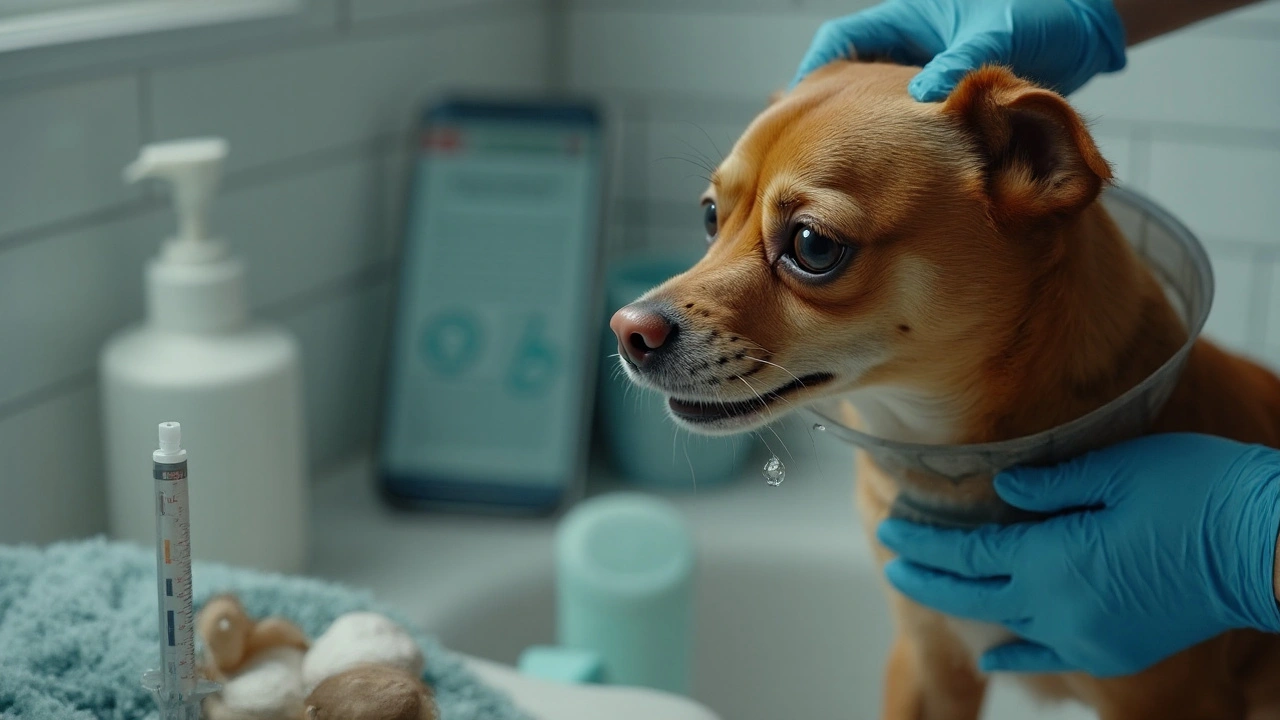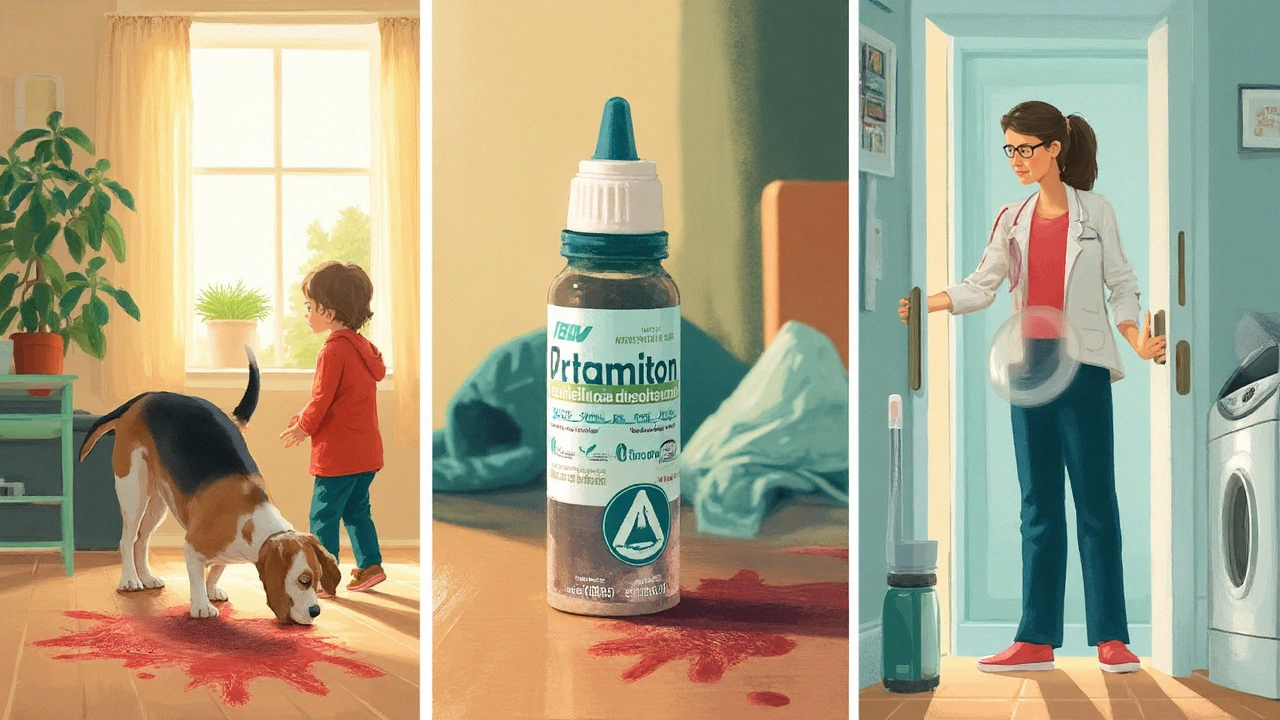If you’ve landed here, you’re likely dealing with a pet that won’t stop scratching and you’ve heard crotamiton might help. Here’s the straight talk: crotamiton is a human anti-itch and scabies lotion/cream that some vets use off-label in dogs for short-term itch relief or as an adjunct in mite cases. It can help, but it’s not first-line for parasites, it’s not registered for animals in many countries (including Australia), and safety data in cats is thin. Expect a practical, step-by-step rundown, clear safety rules, and proven alternatives that often work better.
TL;DR: What pet owners need to know about crotamiton
- Crotamiton is a topical antipruritic (anti-itch) and scabicidal agent licensed for humans; in veterinary medicine it’s off-label and used sparingly.
- Best use-case: short-term itch relief in dogs with localized dermatitis or as a stopgap while definitive treatments kick in; not a first-line mite killer in pets.
- Cats: safety data are limited; many vets avoid it and choose safer, licensed options. Always ask your vet before using on cats.
- Alternatives like isoxazolines (fluralaner, afoxolaner, sarolaner, lotilaner) and selamectin/moxidectin are the go-to for sarcoptic mange and other mites.
- Talk to your vet. In Australia, crotamiton isn’t commonly registered for animals; use is under veterinary direction only.
What crotamiton is-and when vets actually use it
Crotamiton is a topical medication (typically 10% cream or lotion) used in people to calm itching and treat scabies. It has two actions: it reduces the sensation of itch, and it’s scabicidal (it can kill scabies mites). In pets, it’s not a front-row player. Most veterinarians reach for rapidly effective, veterinary-licensed parasiticides instead. So where does crotamiton fit?
Typical veterinary scenarios where crotamiton might be considered:
- Short-term itch relief in dogs: Localized hot-spot-adjacent skin or contact dermatitis while waiting for diagnostics or systemic meds (like oclacitinib or a steroid taper) to work. Think small, contained patches-not full-body coverage.
- Adjunct in sarcoptic mange cases (dogs): When the primary mite-killing plan is already in place (e.g., isoxazoline oral chew), a vet may add a topical antipruritic to reduce scratching and trauma for a few days.
- Post-parasite treatment itch: Even after mites are killed, inflammation lingers. A thin film can sometimes help bridge that gap-but only under veterinary guidance.
Where crotamiton usually isn’t the answer:
- Primary mite control: For sarcoptic mange, demodicosis, or ear mites, licensed parasiticides beat crotamiton for speed, efficacy, and safety profiles in animals.
- Widespread dermatitis: Covering large body areas increases risk of irritation and accidental ingestion.
- Cats: Safety in cats is not well-established; many clinicians avoid it and pick safer topical or systemic options.
What about benefits? When used properly, crotamiton can take the edge off itch quickly, which means less self-trauma, better sleep (for you and your pet), and a calmer window while you wait for the main treatment to kick in. That’s the niche.
What I’ve seen in Perth with my goofy Goldie, Dexter: the real wins for itch and mites here-thanks to our warm climate and year-round flea pressure-come from consistent parasite prevention and quick diagnostics. A short topical add-on can help for a day or two, but the backbone is still a licensed preventative or targeted therapy.
Evidence and references vets actually use: Plumb’s Veterinary Drug Manual notes crotamiton primarily as a human product with limited veterinary use; the Merck Veterinary Manual and BSAVA formulary focus on proven parasiticides for sarcoptic mange; and in Australia, the APVMA product register doesn’t list crotamiton as a common veterinary-registered option as of 2025. Human labels (like FDA monographs) describe 10% creams/lotions for scabies and pruritus, which informs-but doesn’t define-how vets may use it in dogs.

How to apply crotamiton safely if your vet prescribes it
Important: what follows is a safe-use framework, not a one-size-fits-all dose. Always follow your vet’s specific directions. If you don’t have vet instructions, don’t DIY this-book a consult.
General safe-use rules:
- Use only on intact skin-no open wounds, hot-spot cores, or raw chewed areas.
- Small areas only, especially on dogs. Avoid cats unless a vet clearly okays it.
- Prevent licking until fully dry; use an e-collar or T-shirt as needed.
- One product at a time: avoid layering with other topicals unless your vet says it’s okay.
Step-by-step application (typical vet-directed approach):
- Confirm the plan: Clarify with your vet the goal (itch relief vs adjunct to mite control), the body area, and the duration. Many vets limit to a few days.
- Patch test: On first use, apply a pea-sized amount to a 2-3 cm patch of the target area. Wait 12-24 hours. If redness, hives, or heightened itch occur, stop and call your vet.
- Prep the skin: Gently cleanse the area with lukewarm water or a vet-recommended cleanser; pat dry completely. Trim fur if needed so a thin film actually contacts skin.
- Apply a thin film: Massage a very light layer into the affected patch. More is not better; extra product raises irritation and ingestion risk.
- Hands off: Wash your hands with soap after application; avoid touching your eyes or mouth.
- Stop the lick: Fit an e-collar or T-shirt until the area feels dry (usually minutes). Don’t let the dog roll on carpets or bedding before it dries.
- Timing: Follow your vet’s schedule. For itch relief, some vets direct once or twice daily for a few days. Don’t freelance the frequency.
- Reassess: If there’s no improvement in 48-72 hours-or symptoms worsen-pause and contact your vet. Persistent itch often means you’re missing the root cause (mites, fleas, allergies, infection).
Practical tips that actually help:
- Do the first dose during the day so you can watch for reactions.
- Keep the treated area small; if you’re tempted to cover a large patch, you probably need a different therapy.
- If fragrance in human lotions bothers your pet (sniffing, sneezing), ask your vet about fragrance-free options-or a different antipruritic.
- Pair with a plan: if mites are suspected, start a licensed parasiticide the same day, per your vet, so you’re treating cause and symptom together.
Quick checklist before each application:
- Skin is intact, clean, and dry.
- No other topical applied there within the last few hours.
- E-collar or garment ready to prevent licking.
- Vet’s instructions at hand; calendar note set for end-date.
Safety, side effects, and red flags
Species considerations:
- Dogs: Off-label use is common enough in clinics for small areas. Most tolerate it when applied thinly and short-term. Avoid mucous membranes, eyelids, nose, and genital areas.
- Cats: Safety is uncertain. Cats groom aggressively and are more sensitive to topical chemicals. Many vets avoid crotamiton in cats and use licensed alternatives. Never apply without explicit veterinary approval.
- Puppies/kittens: Use extreme caution; skin barrier is thinner, ingestion risk is higher. Vets usually prefer age-appropriate licensed products.
Common side effects (usually mild and localized):
- Temporary stinging or warmth on application.
- Redness or increased scratching at the site.
- Dryness or mild scaling with repeated use.
Less common but important:
- Contact dermatitis (rash, hives, intense itch at site) - stop and speak to your vet.
- Gastrointestinal upset if licked/swallowed - drooling, vomiting, diarrhea. Prevent access and call your vet if symptoms persist.
Drug and product interactions:
- Avoid layering with topical steroids, anesthetics (like lidocaine), or other human creams unless directed; combined irritation or increased absorption can backfire.
- Don’t mix with permethrin products-especially around cats. Keep cat-only spaces and dog-only products separate.
Special populations and cautions:
- Pregnant or lactating pets: limited data-most vets avoid off-label topicals unless benefits clearly outweigh risks.
- Food-producing animals: not appropriate.
- Large surface areas: steer clear. If the problem is that widespread, you need a different approach.
When to call your vet immediately:
- Rapidly spreading redness, welts, or hives near the application site.
- Eye involvement: squinting, pawing, discharge after accidental contact.
- Signs of systemic illness: lethargy, vomiting that doesn’t stop, tremors.
Storage and handling basics:
- Keep at room temperature, away from heat-Perth summers are no joke; don’t leave it in a hot car.
- Secure the cap and store where pets can’t reach.
- Check expiry dates; discard old or separated lotions.
What the literature says: Human labels describe 10% crotamiton applied as a thin film for pruritus and specific regimens for scabies. Veterinary references (Plumb’s, BSAVA) acknowledge its off-label status and limited animal data. Merck Veterinary Manual prioritizes licensed parasiticides for mites in dogs and cats. The Australian Pesticides and Veterinary Medicines Authority (APVMA) database, checked in 2025, does not commonly list animal-registered crotamiton products, reinforcing that use should be under veterinary prescription and oversight.

Alternatives, comparisons, FAQs, and next steps
If your pet’s itch is driven by parasites or allergies, you’ll get better, faster results by targeting the cause. Here’s a simple decision aid I use with clients.
Quick decision guide:
- Is the goal to kill mites? Choose a licensed parasiticide. For dogs: isoxazolines (fluralaner, afoxolaner, sarolaner, lotilaner) or selamectin/moxidectin under vet direction. For cats: selamectin, fluralaner, or moxidectin products labeled for cats.
- Is the goal to calm itch now while the main treatment starts working? Discuss a short course of a safe antipruritic: systemic (oclacitinib, short steroid taper) or vet-recommended topical (hydrocortisone aceponate spray for dogs, medicated shampoos, bland emollients).
- Localized, intact skin patch? Your vet may allow a thin film of crotamiton for dogs for a very short window. Cats-usually no.
- Hot spots, broken skin, ooze? Avoid crotamiton; treat infection/inflammation instead (clip, clean, antimicrobials if needed, anti-inflammatory therapy).
Comparison at a glance (what most vets prefer):
- Isoxazolines: high efficacy against mites and fleas, convenient dosing, strong safety data in dogs and cats (product-specific).
- Selamectin/moxidectin: excellent for sarcoptic mange and ear mites; widely used in both species.
- Lime sulfur dips: old-school but effective for certain mites and fungal issues; smelly, messy, but safe when used correctly.
- Topical steroids/antipruritics (vet-labeled): targeted itch relief with clear dosing and safety data.
- Crotamiton: symptom relief niche, off-label, limited animal data; usually not first choice.
Real-life examples
- Dog with sarcoptic mange: Vet starts sarolaner orally; adds a bland, non-steroid topical for itch the first 48 hours. If the dog is still frantic, a thin film of crotamiton may be used on one or two patches for a day or two-then stopped.
- Dog with contact dermatitis from grass: After confirming no infection, vet advises avoidance, a short oclacitinib course, and a medicated rinse. Crotamiton is considered only if one stubborn patch keeps itching-and for a very short period.
- Cat with suspected mites: The vet prescribes selamectin; itch support comes from cat-safe, labeled products. Crotamiton is skipped.
Mini-FAQ
- Can I buy crotamiton over the counter and try it on my dog? In many places, yes for human use, but don’t self-prescribe for pets. Off-label doesn’t mean casual. Get a vet’s plan first.
- Is crotamiton safe for cats? Safety is unclear and ingestion risk is high. Most vets prefer licensed cat products. Don’t use without explicit veterinary direction.
- Does crotamiton kill mites in pets? It has scabicidal action in humans, but in veterinary practice it’s not relied on as the primary mite treatment. Use licensed parasiticides.
- How long until itch improves? If crotamiton helps, you might see relief within hours. If there’s no change in 1-2 days, rethink the diagnosis and treatment plan.
- Can I layer it with hydrocortisone cream? Only if your vet tells you to. Layering can irritate or alter absorption.
- What about puppies and kittens? Talk to your vet. Most clinicians avoid off-label topicals in very young animals.
Next steps and troubleshooting
- If your pet is still itchy after 48-72 hours: Stop guessing. Ask your vet for skin scrapings (mites), cytology (yeast/bacteria), and consider flea control audit. In Perth, fleas can mimic everything.
- If redness worsens where you applied crotamiton: Wash the area with mild cleanser, rinse well, stop the product, and call your vet.
- If your dog licked it: Offer water, monitor for drooling or vomiting. Call your vet if symptoms show up or if a large amount was ingested.
- If you need something safer for cats: Ask your vet about selamectin/moxidectin for mites and cat-labeled antipruritics or medicated rinses.
- For recurring seasonal itch: Build a prevention plan-year-round parasite control, regular baths with a vet-approved shampoo, allergen avoidance, and dietary review. Dexter’s plan in our Perth home is a monthly isoxazoline and tight flea control, which slashed his spring flares.
Key sources clinicians lean on (no links, ask your vet to reference):
- Plumb’s Veterinary Drug Manual, latest edition
- Merck Veterinary Manual (Dermatology and Parasite sections)
- BSAVA Small Animal Formulary
- FDA human labeling for crotamiton 10% products (for mechanism and human use)
- APVMA product database (Australia), accessed 2025
Bottom line: crotamiton can be a helpful, short-term itch soother in select dog cases, but it’s not a cure for mites and it’s rarely the best first move. If you’re dealing with endless scratching, start with a vet exam, pick a licensed parasiticide when parasites are on the table, and use adjuncts like crotamiton only when your vet says it fits. For searchers after a quick phrase, here it is: crotamiton for dogs can help with localized itch, short-term, under vet guidance-cats, usually no.





13 Comments
Jason Ring
Crotamiton can be a handy stop‑gap for dogs with a tiny hotspot, but you really want a vet‑approved parasiticide for the underlying cause. It works by dulling the itch sensation, giving the pup a break while the real treatment takes effect. Keep the application area small and always use an e‑collar to stop licking. If the irritation persists beyond a couple of days, schedule a check‑up. Remember, the goal is to treat the root problem, not just the symptom.
Kelly Hale
When it comes to itching pets, the temptation to reach for any over‑the‑counter human cream is as strong as the pride we feel defending our four‑legged companions. Yet the reality is that crotamiton, while a miracle for human scabies, is not a miracle for our dogs, and using it without veterinary guidance is akin to marching into battle without a proper shield. In the great tradition of American pet owners who demand the best, we should prioritize products that have been rigorously tested on canine skin. The isoxazolines – fluralaner, afoxolaner, sarolaner and lotilaner – have a track record that rivals the most elite military equipment, delivering rapid mite eradication with minimal side effects. Relying on crotamiton as a first‑line treatment is like trying to win a war with a butter knife. It may soothe the itch for a few fleeting hours, but the underlying parasite will continue its assault, causing more damage and more frustration. Veterinarians across the States have reported that dogs whose owners persist with human lotions often end up with secondary infections that could have been avoided. If you truly love your dog, you will seek a veterinary prescription for a licensed antiparasitic and reserve any human topical only for the short, supervised window the vet authorizes. Applying crotamiton to a large area is a gamble that can lead to ingestion, gastrointestinal upset, and an increased risk of systemic toxicity. In regions like Australia where the drug is not even registered for animal use, the regulatory bodies have effectively drawn a line in the sand. We must respect those lines, just as we respect the borders that keep our nation safe. The short‑term relief it can provide is dwarfed by the potential for harm when misused. Remember that a well‑planned flea and mite prevention program is the true cornerstone of a healthy, itch‑free dog. Think of it as fortifying the castle walls rather than merely plastering over a crack. So, let the science lead, let the vet guide, and let your dog enjoy the peace that comes from proper treatment.
Neviah Abrahams
The slick promise of human creams masks a brutal truth for our dogs the chemistry is not designed for canine skin and the risk of irritation is real. Vets warn that off‑label use can backfire with unforeseen side effects that turn a simple itch into a cascade of problems. Yet owners cling to the allure of quick fixes, ignoring the deeper infestations that demand proper parasiticides. In the end the dog suffers, the owner learns the hard way, and the cycle repeats.
Uju Okonkwo
If you’re worried about the itch, start with a thorough skin exam and a flea audit – that’s the foundation of any treatment plan. Pair any topical relief with a licensed antiparasitic, and you’ll see faster improvement. Remember, we’re all in this together, so don’t hesitate to ask your vet for a step‑by‑step guide.
allen doroteo
Crotamiton is not a miracle cure for mites, just a temporary itch mask.
Corey Jost
While many swear by the newest oral isoxazolines, I still see a place for the old‑school topical crotamiton in specific scenarios. If a dog has a localized hot spot that’s too painful for a systemic drug, a thin film of crotamiton can provide immediate itch relief. The key, however, is strict limitation – only a pea‑sized dab on intact skin for no more than two days. Veterinarians often overlook this because they fear liability, but the literature does note its minimal absorption when used correctly. Ignoring this tool because it’s labeled for humans feels like throwing away a perfectly good hammer just because the manual says it’s for nails. Of course, never apply it on cats – they’re far more sensitive and the risk of toxicity skyrockets. Always combine it with a proper mite‑killing regimen, otherwise you’re just soothing the symptom. So, before dismissing crotamiton outright, consider whether it might fill the short‑term gap in your treatment arsenal.
Nick Ward
I get why you’re looking for quick itch relief – those endless scratches can wear anyone down :) A short course of crotamiton can be useful, but only under vet supervision. Keep the area clean, apply a thin layer, and watch your dog for any signs of irritation. Pair it with a licensed parasite treatment and you’ll likely see the problem fade faster.
felix rochas
Don’t be fooled, the pharma giants don’t want you to know the truth!!! They push patented isoxazolines because they line their pockets, while a simple human cream sits on the shelf, cheap and effective!!! Yet the FDA and APVMA have buried the data on crotamiton’s safety in pets, hiding it behind red tape!!! If you think the vet is just a middleman you’re missing the bigger picture – the entire system is rigged!!! Use caution, read the fine print, and demand transparency!!!
inder kahlon
Patch‑test crotamiton first: apply a pea‑sized amount and wait 24 hours for any reaction. Use it only on small, intact areas and keep the dog from licking until dry. If no improvement after 48 hours, stop and contact your veterinarian.
Dheeraj Mehta
Stay hopeful – even a short‑term itch reliever can buy you time while the real treatment works :) Just monitor your pet closely and report anything unusual to the vet.
Oliver Behr
Crotamiton is a human antipruritic, not a veterinary miracle. Reserve it for brief, vet‑approved use. Otherwise, stick with proven parasiticides.
Tiffany W
The ethical implications of off‑label human dermatologics in companion animal therapy constitute a breach of fiduciary duty and contravene established pharmacovigilance protocols. Employing crotamiton without stringent regulatory endorsement epitomizes a paradigmatic lapse in evidence‑based practice. Practitioners must adhere to the principled framework of the Veterinary Medicines Regulations to safeguard animal welfare. Deviation from this normative standard risks not only clinical repercussions but also moral censure within the professional community.
Rajeshwar N.
While the majority of clinicians favor isoxazolines, data from smaller case series suggest that crotamiton can reduce pruritus in select canine patients. The limitation lies in its lack of mite‑killing potency, making it unsuitable as monotherapy. Its short‑term safety profile appears acceptable when applied to limited skin surfaces. Nonetheless, rigorous randomized trials are needed to substantiate these observations. Until such evidence emerges, the drug should remain an adjunct, not a replacement, for approved antiparasitic regimens.